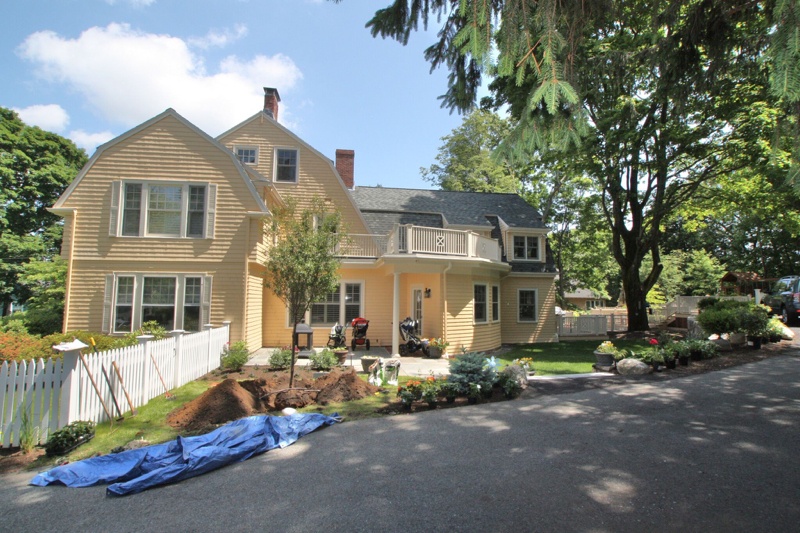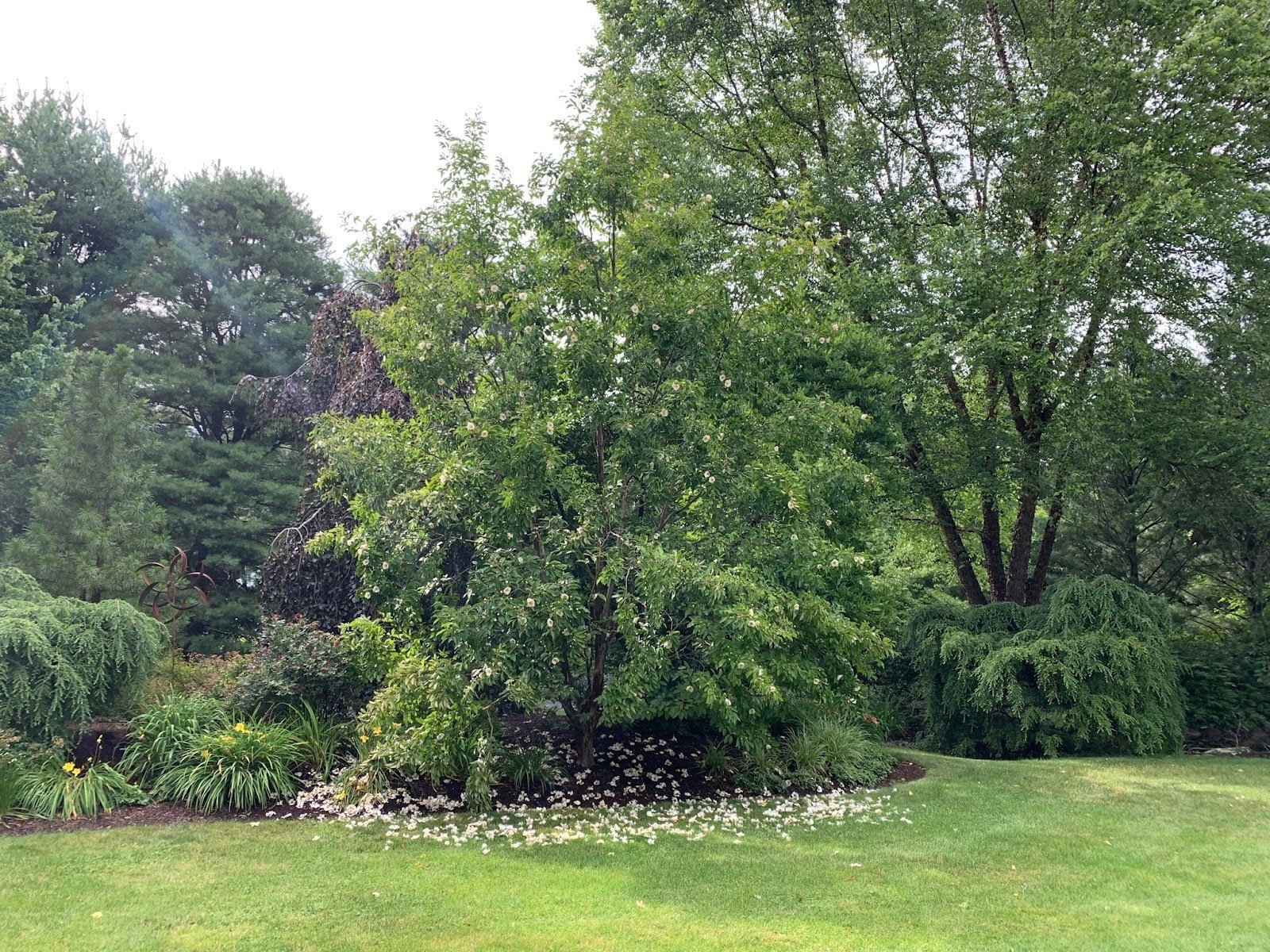Deciduous trees are a versatile, attractive and dynamic element for use in any landscape design because they are powerful players in the environment. These are the trees that have a trunk below and a canopy above. They lose their leaves in winter and go through several changes over the seasons. They create habitat, define space, and offer screening and shade. They build character to the landscape with their many different textures and colors. There’s a wide variety to choose from in any planting zone allowing you to match size, shape and compatibility to your location and project.
Three Critical Considerations for Tree Selection
- Selecting the right tree type (genus & species) for your property requires knowing something about the horticultural aspects of the tree. What does it like/need, what are it’s best features, what might harm the tree in the future, how can you help care for it?
- Choose the shape and form of the tree to complement the look or function you desire and drive the overall character you are targeting for the landscape.
- Identify the correct placement of your tree for present goals while considering the future impacts of that placement many years from now.
Properly attending to the above three selection criteria will significantly reduce long-term maintenance costs while increasing the trees’ effectiveness and value as an integral part of a landscape design.

This Higan Cherry tree (Prunus subhirtella 'Autumnalis') was planted as a special family tree in a location where it has plenty of room to get tall and wide over many years.
Tree Size When Purchased Matters
The biggest mistake many property owners make is looking at how big a tree is when they purchase it, not how big it will be when it matures.
 Some buy saplings because they cost less, and they can get more trees for their money. While I have seen sapling plantings work in larger restoration projects, they are generally not the way to go in a managed private or commercial landscape. They’re simply too small and weak and will have little to no effect or impact on your landscape design until long after you’ve moved on from that space or the planet.
Some buy saplings because they cost less, and they can get more trees for their money. While I have seen sapling plantings work in larger restoration projects, they are generally not the way to go in a managed private or commercial landscape. They’re simply too small and weak and will have little to no effect or impact on your landscape design until long after you’ve moved on from that space or the planet.
In short, these tiny beginnings of trees are generally NOT a good strategy for building a landscape that you hope to enjoy now and in the near future. They’re better suited for a farming strategy – raising trees to sell or transplant later – and for restoration projects.
When you talk about tree size professionally, you're referring to the diameter of the tree's trunk or caliper measurement. This measurement is taken approximately six inches from the root flare, which is at the base of the tree where it starts to spread out to enter the ground.
This measurement can also be used to calculate how long it will take for the tree to establish. Keep in mind, this calculation is simply a good “guess” and assumes that the planted tree was selected using the above three criteria. For example, a tree with a caliper measurement of three inches will take an average of three years to establish itself in a new location. Where a tree of one-inch caliper should only take about one year to establish.
What do I mean by establish? There are two phases that any plant goes through when it’s transplanted from a nursery (grower) to a new landscape. The bigger the plant…the longer time it spends in each of these phases.
- Phase one: Acclimation – this is the period of time the plant takes to get out of shock and beyond the stress of the disruption of the move. It's basically like triage, and you are the doc caring for your patient while it recovers enough to heal with less attention.
- Phase two: Establishment – this is the time it takes for this plant to put out enough roots so that it can begin to grow at its normal pace. This phase is that point when the doc knows you are well enough to take care of yourself, but puts you on a check-in schedule for updates and follow-up care actions.
Now, if you do the simple math; that one-inch caliper tree will start growing at its normal pace in about a year or so, while that three-inch caliper tree will take closer to three years before it catches its pace. The result: by year four these trees may be close to the same size!
So how do you choose?
- Money is one consideration. A three-inch caliper tree is far more expensive than a one-inch caliper tree, so that’s a start. How much do you want to spend?
- Size in the landscape is the second consideration. A three-inch caliper tree will have more presence in the landscape now. That one-inch caliper tree won’t have a lot of impact initially. What’s your patience level?
- Transport is a third consideration. A three-inch caliper tree is a heavy plant. You can’t pick it up by hand. Maybe you can roll it with some effort, but it’s best handled by a machine and it will need a large truck to get from point A to point B. That one-inch tree can be lifted and transported easily. Are you tackling the tree planting as a DIY project or have you hired a professional to do it for you?
Often I am asked, “Well how about a “mature” tree, could we plant one of those?”
Here's my answer, if you do the math above – and purchase a six or eight-inch caliper tree (still not mature mind you), how long do you imagine it would take for it to get out of the acclimation/establishment phase? Are you prepared for that amount of work?
These much larger trees, which are available for many thousands of dollars (sometimes tens of thousands), while not mature yet, have many years of growth under their belt and are really big and heavy. To state my take on these trees, I'd like to use this adage, “The bigger they are; the harder they fall.” These larger specimens are not as resilient as their smaller more youthful brethren. Think of it this way, if you move to a new town, or state, or country when you are a kid, it may be a bit disrupting, but if all is good and healthy when you get there, you'll bounce back, and that new place will feel like home in no time.
For adults, it is harder. We pine for home, we miss our friends and family, we travel back and forth, and sometimes the stress of it takes a toll on our health. While we can do it, it is just harder emotionally. SO…I know we aren't trees, but I hope you can see the life correlation. Trees, like people, are living breathing things; a more youthful specimen offers more resilience.
I have seen several enormous tree moves and my assessment is that about a third die within the first three years (after your guarantee runs out), a third fail to thrive and limp along for years, and the other third…well they often need to be cut down because they do so well that as they start to mature they crowd plants around them, infiltrate garden areas with roots, and become incompatible with structures and hardscape.
So much for instant gratification! Remember, most trees get WAY bigger than you think, and unless you have given the tree ample room to mature, you could feel crowded before you know it.
There is a sweet spot in my opinion, and that’s a tree between a two and three-inch caliper. In the nurseries they are listed in ranges – 1.5-2", 2-2.5", 2.5-3”, 3-3.5” – and these four choices I think give the best versatility in design and the most success in acclimation and establishment.

TWEETABLE TIP
Trees are an attractive and dynamic element for use in any landscape design, so choose the right planting size!
VIA @GardenContinuum

You can have amazing tree planning success and terrific landscape satisfaction when the Right Tree is chosen for the Right Place!









Leave a comment